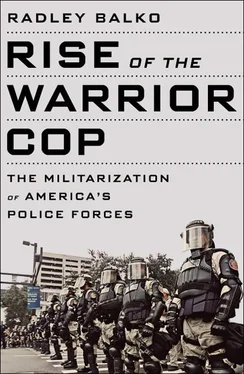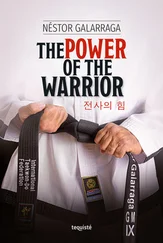Based on interviews with several Black Panthers who were in the building the morning of the raid, as well as with LAPD SWAT officer Patrick McKinley, journalist Matthew Fleischer offers a different narrative:
On November 28, 1969, more than 250 police officers surrounded the Los Angeles [Black Panther] headquarters during a community meeting, sealing the facility off in what Panthers now call the “test run.”
On December 4, Fred Hampton, deputy chairman of the Illinois chapter of the Black Panthers, was shot to death at point-blank range while he was sleeping, during a raid by the Chicago Police Department. The incident drew international outrage. Back in LA, there wasn’t a Panther alive who didn’t think a similar raid by the LAPD was coming their way.
They were right. As it turns out, the night of the test run, police claimed to have seen three Panthers—Paul Redd, “Duck” Smith and Geronimo Pratt—in possession of illegal firearms. The LAPD secured an arrest warrant for the three, as well as a search warrant for the 41st and Central headquarters and two known Panther hideouts. 81
By all accounts, the raid began at about 5:30 AM on December 6, 1969. The Black Panther building was well armed and well fortified. Gates and his SWAT team had put together blueprints of the building from intelligence they had collected from informants. Unfortunately, the blueprints critically misplaced a massive pile of dirt that the Panthers had built while digging out escape tunnels. The police had the dirt pile off in a corner. It was actually directly behind the back door, the same door through which the assault team was to make its surprise entry. 82
When they tried to open the back door, the dirt pile prevented them from entering. They’d have to go through the front door. As they did, a helicopter swarmed overhead, and other officers began scaling the sides of the building. By plan, Gates’s SWAT team was supposed to have made entry and secured the inside of the building by this point. Instead, a Panther lookout on the roof screamed, “They’re here!” to his confederates inside. By the time the SWAT team breached the front door, the Panthers were ready and greeted them with a storm of bullets. Three officers went down.
Even worse, the SWAT team had entered an alcove with no escape except through the door they had just entered. Fortunately, the gunfire had started immediately, which let the officers know their cover had been blown. They dragged out their fallen colleagues and retreated. As Fleischer puts it, “If the Panthers had held their fire for a few moments more, the entire SWAT team would have made it into the alcove—and been shot to pieces.” 83
Over the next three hours, LA police and the Black Panthers exchanged over five thousand rounds in a crowded city setting. The entire neighborhood was evacuated, and the surrounding streets were shut down just before the morning rush hour. Los Angeles police chief Ed Davis was in Mexico at the time, making Gates the acting chief. After a couple hours of gunfire, Gates and his SWAT officers came up with a new idea—they would use a grenade launcher on the building. Gates contacted the Marines at Camp Pendleton. He was told that, at the very least, he’d need permission from the Department of Defense. He’d probably also need it from the president. Gates writes in his book, “I called Mayor Sam Yorty next and asked if he would make the call to Washington. My words seemed unreal. Anytime you even talk about using military equipment in a civil action, it’s very serious business. You’re bridging an enormous gap.” 84
Yorty agreed, and within an hour the Department of Defense gave Gates permission to use a grenade launcher on the Panthers building. It’s a remarkable anecdote, not because Gates sought permission to use the weapon, or even because the Pentagon gave it to him. Given the circumstances, it may not even have been all that unreasonable a request. The story is remarkable because of the procedures, the caution, and the trepidation that went into procuring the grenade launcher. About twenty years later, the Pentagon would begin giving away millions of pieces of military equipment to police departments across the country for everyday use —including plenty of grenade launchers.
The accounts of the raid again differ about how it ended, but after hours of gunfire the Panthers finally waved a white flag to surrender. In the end, four Black Panthers and four LAPD officers were wounded. Somehow, no one was killed. Six Panthers were arrested, booked, charged, and jailed. If the objective of the SWAT team was to serve the warrants and make the arrests with no fatalities, then the raid was a success. But of course it was far from that. The SWAT officer McKinley summed up the raid to Fleischer. “Oh God, we were lucky…. I’m extremely proud of what we did that day. We got our targets and no one died. But oh God, were we lucky.”
Gates’s surprise tactics had one unexpectedly deleterious effect: they gave the Panthers a plausible argument of self-defense. The Panthers awoke to men with guns breaking down their door and firing bullets into the walls. Paramilitary police tactics were new at the time, and the mixed-race jury apparently found them pretty alarming. All six Panthers were acquitted of the most serious charges, including conspiracy to murder police officers. That again is a stark illustration of how much standards and expectations have changed since then. It’s nearly unthinkable that a self-defense claim under similar circumstances would be successful today. Indeed, several subjects of these sorts of raids have made that argument, and they almost always have failed.
Though it was only by sheer luck that the bumbling raid wasn’t a bloody disaster, and the tactics themselves ultimately contributed to acquittals of the very dangerous suspects the entire operation was designed to put in prison, the country’s maiden high-profile SWAT raid was also a massive, uncompromising show of force against an organization that was widely feared and despised by politicians, law enforcement officials, and most Americans whose politics fell outside the far left. Activists and editorial boards raged, but the Black Panther raid was a public relations triumph. Within five years the Panthers would splinter, fizzle, and for the most part evaporate. SWAT would grow, spread to other cities, and become a pop culture phenomenon.
By the time Gates died in 2010, the institution he started had spread to nearly every city in the country, to most federal agencies, to most medium-sized towns, and even to small and tiny towns. The wisdom of limiting SWAT assaults to genuine emergencies was long gone. Across the country, the tactics Gates had conceived to stop snipers and rioters—people already committing violent crimes—had come to be used primarily to serve warrants on people suspected of nonviolent crimes.
The Numbers
 Percentage of Americans who thought the Supreme Court was too soft on criminals in 1965: 48 percent
Percentage of Americans who thought the Supreme Court was too soft on criminals in 1965: 48 percent
… in 1968: 63 percent
… in 1969: 75 percent
 Percentage of Americans in 1968 who disapproved of interracial marriage: 75 percent
Percentage of Americans in 1968 who disapproved of interracial marriage: 75 percent
 Percentage of Americans who supported the Chicago police after the 1968 Democratic National Convention riots: 56 percent
Percentage of Americans who supported the Chicago police after the 1968 Democratic National Convention riots: 56 percent
… of Nixon supporters: 63 percent
… of Wallace supporters: 71 percent
… of Humphrey supporters: 44 percent
 Percentage of Americans who supported the death penalty in 1966: 42 percent
Percentage of Americans who supported the death penalty in 1966: 42 percent
Читать дальше

 Percentage of Americans who thought the Supreme Court was too soft on criminals in 1965: 48 percent
Percentage of Americans who thought the Supreme Court was too soft on criminals in 1965: 48 percent










